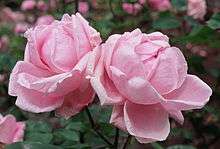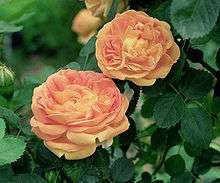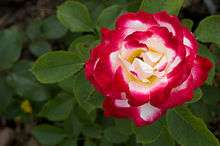Hybrid tea rose
Hybrid tea is an informal horticultural classification for a group of garden roses.[1] They were created by cross-breeding two types of roses, initially by hybridising hybrid perpetuals with tea roses. It is the oldest group classified as a modern garden rose.
Hybrid teas exhibit traits midway between both parents, being hardier than the often quite tender teas (although not as hardy as the hybrid perpetuals), and more inclined to repeat-flowering than the somewhat misleadingly-named hybrid perpetuals (if not quite as ever-blooming as the teas).
Hybrid tea flowers are well-formed with large, high-centred buds, supported by long, straight and upright stems. Each flower can grow to 8-12.5 cm wide. Hybrid teas are the world's most popular type of rose[2] by choice due to their color and flower form. Their flowers are usually borne singly at the end of long stems which makes them popular as cut flowers.
Most hybrid tea bushes tend to be somewhat upright in habit, and reach between 0.75 and 2.0 metres in height, depending on the cultivar, growing conditions and pruning regime. It is the provincial flower of Islamabad capital territory.
History


The birth of the world's first hybrid tea is generally accepted[3] to have been 'La France' in 1867. It was raised by Jean-Baptiste André Guillot, a French nurseryman.[4] He did it by hybridising a tea rose, supposedly 'Madame Bravy,' with a hybrid perpetual, supposedly 'Madame Victor Verdier', hence 'hybrid tea.'
Other early cultivars were 'Lady Mary Fitzwilliam' (Bennett 1883), 'Souvenir of Wootton' (John Cook 1888) and 'Mme. Caroline Testout', introduced by Pernet-Ducher in 1890.
Hybrid tea roses did not become popular until the beginning of the 20th century, when Pernet-Ducher in Lyons, France, bred the cultivar 'Soleil d'Or' (1900).[5] But the cultivar that made hybrid teas the most popular class of garden rose of the 20th century was the rose Peace ('Madame A. Meilland'), introduced by Francis Meilland at the end of World War II, and one of the most popular rose cultivars of the 20th century.
Michele Meilland Richardier cultivated a hybrid tea which had double flowers, with a coral inside and a yellow and pink outside. It was said to last very well when cut.[6] The rose was classified as being part of the meilimona variety. The patent was filed on October 14, 1975 and was issued February 1, 1977.[7]
Most hybrid tea cultivars are not fully hardy in continental areas with very cold winters (below −25 °C). This, combined with their tendency to be stiffly upright, sparsely foliaged and often not resistant to diseases, has led to a decline in hybrid tea popularity among gardeners and landscapers in favor of lower-maintenance "landscape" roses. The hybrid tea remains the standard rose of the floral industry, however, and is still favored in small gardens in formal situations.
Propagation
This is usually done by budding, a technique that involves grafting buds from a parent plant onto strongly growing rootstocks. One such rootstock is R. multiflora.
Hybrid tea cultivars bred in continental areas (e.g. Canada) tend to be hardier than those hailing from more maritime regions (e.g. New Zealand).
Examples

A very large number of hybrid tea cultivars have been introduced by breeders over the years; some notable examples include 'Chrysler Imperial', 'Double Delight', 'Elina', 'Fragrant Cloud', 'Mister Lincoln', Peace and 'Precious Platinum'.
References
- ↑ "Classification of genera". Royal Horticultural Society. Retrieved 2012-03-16.
- ↑ D.G. Hessayon. The Rose Expert. Mohn Media Mohndrunk. p. 9.
- ↑ "La France: Hybrid Tea Rose". RoseGathering.com. Retrieved 2009-09-18.
- ↑ "Guillot". HelpMeFind.com. Retrieved 2009-09-18.
- ↑ D.G. Hessayon, The Rose Expert, Mohn Media Mohndrunk, p. 9
- ↑ Autumn, Stanley (October 1, 1995). Mothers and Daughters of Invention: Notes for a Revised History of Technology (1st ed.). Rutgers University Press. pp. 37–38. ISBN 0813521971. Retrieved 11 December 2014.
- ↑ "Patents by Inventor Michele Meilland Richardier". Justia Patents. Retrieved 11 December 2014.
External links
 Media related to Hybrid tea rose at Wikimedia Commons
Media related to Hybrid tea rose at Wikimedia Commons